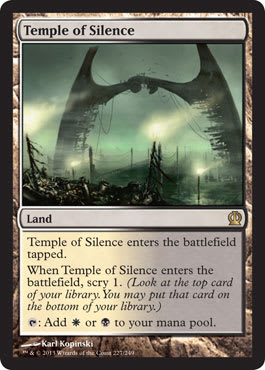In preparation for the Pro Tour Qualifier season as well as the upcoming StarCityGames Invitational in Las Vegas, I’ve been taking a hard look at the control decks that have been floating about. With the temporary loss of Magic Online Daily Events, the main go-to source for decks are the Grands Prix and SCG Opens that have been taking place almost every weekend for the past month.
W/U control is the most prominent control deck at the moment.
"William “Huey” Jensen’s W/U Control"
- Planeswalkers (4)
- 1 Elspeth, Sun's Champion
- 3 Jace, Architect of Thought
- Spells (30)
- 2 Quicken
- 2 Syncopate
- 4 Azorius Charm
- 4 Dissolve
- 4 Sphinx's Revelation
- 4 Divination
- 4 Supreme Verdict
- 4 Detention Sphere
- 1 Elixir of Immortality
- 1 Ratchet Bomb
- Lands (26)
- 8 Island
- 8 Plains
- 2 Mutavault
- 4 Azorius Guildgate
- 4 Hallowed Fountain
- Sideboard (15)
- 1 Blind Obedience
- 3 Fiendslayer Paladin
- 3 Gainsay
- 1 Jace, Memory Adept
- 3 Last Breath
- 2 Negate
- 1 Pithing Needle
- 1 Ratchet Bomb
"Joe Lossett’s W/U Control"
- Planeswalkers (7)
- 3 Elspeth, Sun's Champion
- 4 Jace, Architect of Thought
- Spells (27)
- 1 Essence Scatter
- 2 Syncopate
- 3 Azorius Charm
- 3 Dissolve
- 3 Last Breath
- 4 Sphinx's Revelation
- 2 Divination
- 4 Supreme Verdict
- 4 Detention Sphere
- 1 Elixir of Immortality
- Lands (26)
- 6 Island
- 6 Plains
- 2 Mutavault
- 2 Temple of Deceit
- 2 Temple of Silence
- 4 Azorius Guildgate
- 4 Hallowed Fountain
- Sideboard (15)
- 2 Pithing Needle
- 1 Aetherling
- 3 Celestial Flare
- 4 Gainsay
- 1 Last Breath
- 1 Negate
- 1 Sundering Growth
- 1 Jace, Memory Adept
- 1 Unknown Card
"Seth Manfield's W/U Control"
- Creatures (1)
- 1 Aetherling
- Planeswalkers (6)
- 2 Elspeth, Sun's Champion
- 4 Jace, Architect of Thought
- Spells (26)
- 2 Essence Scatter
- 4 Azorius Charm
- 4 Dissolve
- 4 Last Breath
- 4 Sphinx's Revelation
- 4 Supreme Verdict
- 4 Detention Sphere
- Lands (27)
- 6 Plains
- 7 Island
- 2 Mutavault
- 2 Temple of Deceit
- 2 Temple of Silence
- 4 Azorius Guildgate
- 4 Hallowed Fountain
- Sideboard (15)
- 1 Pithing Needle
- 1 Archangel of Thune
- 2 Fiendslayer Paladin
- 4 Soldier of the Pantheon
- 2 Celestial Flare
- 4 Gainsay
- 1 Negate
These decks share the same core of cards: twenty-six lands, one Elixir of Immortality, four Sphinx's Revelation, and four Supreme Verdict. They both eschew creatures in the main deck, and that blanks a lot of cards (especially in mono-black).
Where they differ is actually the interesting part: Given how long the games go with this type of deck, (turn fifteen or later isn’t uncommon), the difference of a three-of versus a four-of is magnified, as is the presence of a one-of.
In addition, Joe Lossett chose to play four scry lands over two Plains and two Islands in the Huey list. That gives him a slight leg up against the heavy black decks and the mirror from his lands.
I prefer the Huey list. With the full boat of Sphinx's Revelations and Divinations, it’s a lot easier to recover from the heavy discard that mono-black and Orzhov present.
Elixir of Immortality in two of the lists gives you inevitability in every single matchup. Seth eschewed the Elixir of Immortality, although on closer examination, it looks as though he just ran back Stanislav Cifka's deck from Grand Prix Vienna.
Eventually, you will reach a point at which you can chain Sphinx's Revelation for 10 or more every turn, and most people cannot beat you through that. In addition, Elixir of Immortality lets you rebuy any discarded win conditions (Elspeth, Sun's Champion and Jace, Architect of Thought) to actually win the game if necessary (although most people should consider conceding the game there to conserve time on the clock if you have reached this point).
Pros of this archetype: You take a lot less damage than Esper most of the time, and you have fewer enter-the-battlefield-tapped lands.
Cons of this archetype: There is a cost to losing black as compared to Esper control, and that cost is losing the ability to look at your opponent’s hand against a control deck or a mono-black devotion deck.
"Marlon Gutierrez's Orzhov Control"
- Creatures (13)
- 1 Sin Collector
- 4 Blood Baron of Vizkopa
- 4 Desecration Demon
- 4 Pack Rat
- Spells (22)
- 2 Last Breath
- 2 Ultimate Price
- 4 Devour Flesh
- 4 Hero's Downfall
- 2 Duress
- 4 Thoughtseize
- 4 Underworld Connections
- Lands (25)
- 1 Plains
- 12 Swamp
- 4 Godless Shrine
- 4 Mutavault
- 4 Temple of Silence
- Sideboard (15)
- 3 Dark Betrayal
- 1 Doom Blade
- 1 Duress
- 3 Lifebane Zombie
- 3 Pharika's Cure
- 1 Pithing Needle
- 1 Shrivel
- 2 Sin Collector
This deck closely resembles the mono-black devotion deck. What's notable at this deck is the way it's constructed to simultaneously prey upon the other black decks and Sphinx's Revelation decks with seven discard spells. To make room for more discard, removal, and Blood Barons, he eschews the Gray Merchant of Asphodel package, as well as Whip of Erebos.
He also has a great plan for opposing Blood Barons in Game 1: the full package of Devour Flesh. The only questionable card to me is Ultimate Price. I don't think it's particularly well-positioned right now, but diversifying your removal does have benefits. However, Ultimate Price doesn't deal with any gold creature or Mutavault.
Pros: This deck has better game against the black mirrors and control decks than normal mono-black.
Cons: Red and/or white aggressive decks still seem pretty hard to beat. The mana curve leaves something to be desired here.
"Robin Dolar's Esper Control"
- Creatures (2)
- 2 Aetherling
- Planeswalkers (4)
- 4 Jace, Architect of Thought
- Spells (27)
- 1 Devour Flesh
- 1 Dimir Charm
- 1 Doom Blade
- 1 Far // Away
- 1 Syncopate
- 1 Ultimate Price
- 2 Dissolve
- 2 Hero's Downfall
- 3 Azorius Charm
- 4 Sphinx's Revelation
- 2 Thoughtseize
- 4 Supreme Verdict
- 4 Detention Sphere
- Lands (27)
- 4 Island
- 4 Plains
- 3 Godless Shrine
- 4 Hallowed Fountain
- 4 Temple of Deceit
- 4 Temple of Silence
- 4 Watery Grave
- Sideboard (15)
- 1 Pithing Needle
- 2 Blood Baron of Vizkopa
- 3 Fiendslayer Paladin
- 3 Pack Rat
- 1 Doom Blade
- 3 Gainsay
- 1 Shrivel
- 1 Thoughtseize
Robin Dolar made the finals of Grand Prix Vienna with this deck, which has a lot of raw power. With eight scry lands and twenty-seven lands, it's difficult to be completely mana-screwed or mana-flooded.
I don't particularly care for the second Aetherling—drawing the first one is bad enough against aggressive decks, and running the risk of drawing a second do-nothing slow card is a huge liability.
In addition, in control mirrors, you typically need to carve out a window to safely resolve Aetherling without your opponent casting Aetherling right after you., and drawing a second one doesn't help there at all.
Note again that Robin chooses to diversify his removal simply because in different situations, you'd rather have different removal spells. Far // Away hasn't been played for a while, but it serves as a miniature Supreme Verdict often on 5 mana. Dimir Charm is an interesting answer that can kill gold creatures, Mutavault, and Master of Waves alike while not being completely dead against other control decks.
"Mono-Black Control by Haibing Hu"
- Creatures (17)
- 4 Desecration Demon
- 4 Gray Merchant of Asphodel
- 4 Nightveil Specter
- 4 Pack Rat
- 1 Erebos, God of the Dead
- Spells (17)
- 1 Doom Blade
- 2 Devour Flesh
- 2 Ultimate Price
- 4 Hero's Downfall
- 4 Thoughtseize
- 4 Underworld Connections
- Lands (26)
- 19 Swamp
- 3 Temple of Deceit
- 4 Mutavault
- Sideboard (15)
- 3 Lifebane Zombie
- 3 Dark Betrayal
- 2 Doom Blade
- 2 Pharika's Cure
- 1 Erebos, God of the Dead
- 3 Duress
- 1 Shrivel
Haibing's mono-black list appears to be only one card off from Owen Turtenwald's list from Grand Prix Albuquerque. Namely, one Pharika's Cure in the sideboard become a second Doom Blade.
This is definitely a control deck, with a whopping nine removal spells in the main deck (as well as a bunch more in the sideboard). Nightveil Specter and Underworld Connections both let you get ahead on cards when you have stabilized in the board.
I think splitting the Temples is closer to correct (albeit not by much) due to the presence of Nightveil Specter in your deck. Either you split it two-and-one in either direction (Temple of Deceit or Temple of Silence) or you could just add another Temple for another Swamp, making it a completely even split of U/B versus W/B Temples.
Pros: Most of your matchups feel extremely close since you have an extremely smooth and consistent deck with enough removal to handle most problems.
Cons: Some of the faster aggressive decks give you problems, especially white and red aggressive decks due to your mana curve being extremely clogged at 3. In addition, the mirror seems kind of akin to flipping coins.
To Summarize
I think all of the control decks above are quite solid as choices for either the Invitational or the upcoming PTQ season. I am likely to play Esper control in the Invitational and PTQs since I've played the most with it, and I am quite comfortable with sideboarding.
If that's not up your alley, mono-blue devotion, Mihara R/G Ramp, Boros/Orzhov aggro (heavily white-based with a splash of either black or red), and mono-red aggro also seem like solid choices.
I'm not a huge fan of the bigger red devotion deck with Stormbreath Dragons since its game plan seems a bit schizophrenic.
However, I do believe that a large majority of Standard decks can succeed as long as you know your deck extremely well and have coherent game plans for post-sideboard games.
Good luck in any tournaments you might have coming up, and thanks for reading.
Please leave any comments here or on Twitter @jkyu06.
Jarvis



























